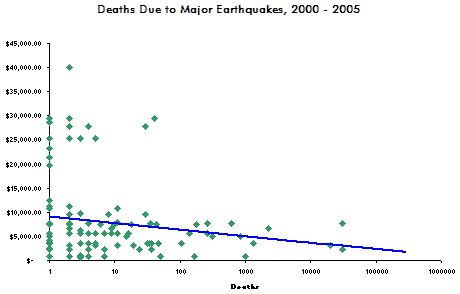Brian Gongol
In light of the October 2005 earthquake in the India/Pakistan region in which tens of thousands of people were killed and many more injured, it's worth noting that the best lifesaving tool in the world may be basic economic growth. An analysis of the world's earthquakes from 2000 through October 2005, based on data from the US Geological Survey, indicates that the lower a country's per capita GDP (according to the CIA World Factbook's 2004 rankings), the higher the likely death toll from a major earthquake.

The line in the graph above is a logarithmic regression on the number of deaths due to quakes versus the GDP per capita in the main country affected. Where a quake occurred in a border region between two countries, the higher GDP was used. Note that the "Deaths" axis is logarithmic; in the past five years, no country with a per-capita GDP of more than $15,000 has lost even 100 people in any earthquake.
When viewed as a lifesaving tool, growth-oriented economics gains a moral authority its opponents often overlook. Growth in the world's poor countries generally requires two ingredients: Access to free trade and the rule of law, particularly as it applies to property law.
This matter is particularly important as the world goes through another phase of donor fatigue, in which people tire of giving to charity in response to new events. And while donating to disaster relief may be a reasonable thing to do on balance, it doesn't usually solve long-term systemic problems of infrastructure and investment in prevention that could help save lives in the future.
